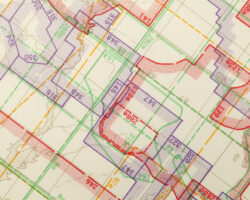Do I Need a Compass to Read a Topographic Map in Texas?
 Do I Need a Compass to Read a Topographic Map in Texas?
Do I Need a Compass to Read a Topographic Map in Texas?
Topographic maps are essential tools for outdoor enthusiasts, hikers, and anyone who wants to navigate and explore the great outdoors. These maps provide valuable information about the terrain, elevation, and natural features of a specific area. But do you really need a compass to read a topographic map in Texas? In this blog post, our land surveyors will explore the role of a compass in navigating topographic maps and discuss the importance of compass skills for outdoor adventurers.
Understanding Topographic Maps
Before diving into compass usage, let’s first understand what topographic maps are. Topographic maps represent the physical features of an area in a detailed and systematic manner. Using topographic surveying, they feature contour lines to depict changes in elevation, helping readers visualize the shape of the land. Topographic maps also include symbols and coloration to represent vegetation, water bodies, roads, and other features of the landscape.
Why Use a Compass?
While topographic maps provide a wealth of information, a compass is a valuable tool for orienting yourself within the map and navigating the terrain. Here’s why a compass is important:
1. Establishing Direction: A compass allows you to determine north, south, east, and west on a topographic map. By aligning the map with the compass, you can orient yourself and understand the direction you need to move in.
2. Navigating Contour Lines: Contour lines are essential for understanding the elevation changes in an area. By combining your compass readings with the contour lines on the map, you can determine whether you’ll be ascending or descending a slope and make informed decisions about your route.
3. Working Without Signals: Unlike GPS devices or smartphone apps, a compass does not rely on signals or batteries. It is a trusty tool that can be relied upon in remote areas, regardless of signal availability or battery life.
Using a Compass With a Topographic Map
Now that we understand the importance of a compass, let’s look at how it can be used with a topographic map in Texas:
1. Orientation: To get started, place your map on a flat surface and identify prominent features depicted on the map, such as roads, mountain peaks, or lakes. Using the compass, align the magnetic needle with the true north arrow on the map. This will ensure that the map is oriented correctly.
2. Determining Direction: With your map oriented correctly, you can use the compass to determine the direction of your destination or the next landmark you want to reach. By holding the compass in front of you and aligning the magnetic needle with the orienting arrow, you can read the bearing indicated by the degree markings around the compass housing. This bearing represents the direction you need to go.
3. Following Your Bearing: Once you have determined your desired direction, use the map’s contour lines and symbols to plan your route and identify landmarks that will keep you on track. As you progress along your route, periodically check your compass to ensure you’re staying on the correct bearing.
Compass Skills for Outdoor Adventures
While compasses are valuable tools for navigating topographic maps, they require some skills to be used effectively. Here are a few compass skills to develop for your outdoor adventures:
1. Reading a Compass: Familiarize yourself with the different parts of a compass, including the magnetic needle, orienting arrow, and degree markings. Learn how to properly hold and use the compass for accurate readings.
2. Understanding Declination: Declination is the angle between true north and magnetic north. It varies depending on your location and can affect the accuracy of your compass readings. Understanding and compensating for declination ensures that your compass readings align with the map’s true north.
3. Taking Bearings: Practice taking accurate bearings by aligning the compass with features on the map and reading the degree markings. This skill allows you to plot and follow a precise route on the map.
4. Using Triangulation: Triangulation involves using the compass to determine your position by identifying three different landmarks and measuring their bearings. This skill is helpful when visibility is limited or when you’re trying to pinpoint your location on the map.
Conclusion
While it is possible to navigate a topographic map without a compass, using a compass greatly enhances your ability to interpret and navigate the map accurately. A compass helps you establish direction, navigate contour lines, and stay on course when exploring unfamiliar terrain. By developing compass skills and regularly practicing with a topographic map, you can confidently navigate the great outdoors and enjoy your adventures to the fullest.